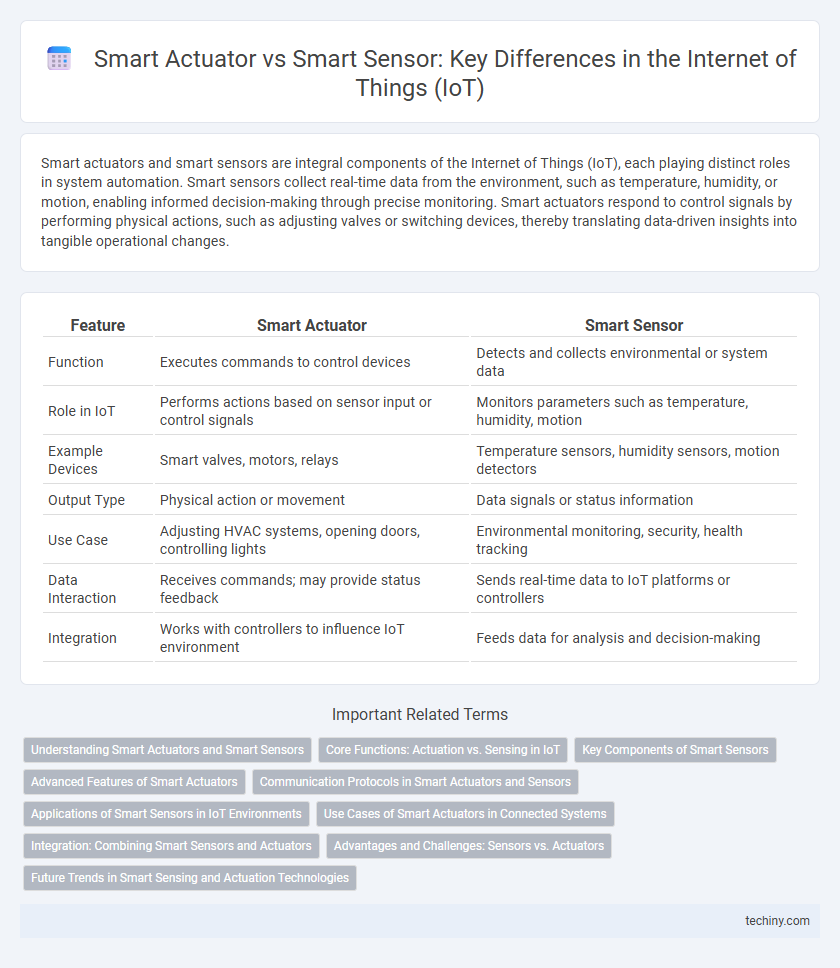Smart actuators and smart sensors are integral components of the Internet of Things (IoT), each playing distinct roles in system automation. Smart sensors collect real-time data from the environment, such as temperature, humidity, or motion, enabling informed decision-making through precise monitoring. Smart actuators respond to control signals by performing physical actions, such as adjusting valves or switching devices, thereby translating data-driven insights into tangible operational changes.
Table of Comparison
| Feature | Smart Actuator | Smart Sensor |
|---|---|---|
| Function | Executes commands to control devices | Detects and collects environmental or system data |
| Role in IoT | Performs actions based on sensor input or control signals | Monitors parameters such as temperature, humidity, motion |
| Example Devices | Smart valves, motors, relays | Temperature sensors, humidity sensors, motion detectors |
| Output Type | Physical action or movement | Data signals or status information |
| Use Case | Adjusting HVAC systems, opening doors, controlling lights | Environmental monitoring, security, health tracking |
| Data Interaction | Receives commands; may provide status feedback | Sends real-time data to IoT platforms or controllers |
| Integration | Works with controllers to influence IoT environment | Feeds data for analysis and decision-making |
Understanding Smart Actuators and Smart Sensors
Smart actuators convert electrical signals into physical actions, enabling devices within the Internet of Things (IoT) ecosystem to interact dynamically with their environment by controlling mechanisms like motors, valves, or switches. Smart sensors collect and process environmental data, such as temperature, humidity, or motion, providing real-time feedback that supports intelligent decision-making in IoT systems. Understanding the complementary roles of smart actuators and sensors is critical for designing efficient, responsive IoT solutions that seamlessly monitor and control physical processes.
Core Functions: Actuation vs. Sensing in IoT
Smart actuators in IoT perform the core function of actuation by converting electrical signals into physical actions, enabling devices to interact dynamically with their environment. Smart sensors focus on sensing by detecting and monitoring environmental parameters such as temperature, humidity, and motion, providing critical data for analysis. The interplay between smart actuators and smart sensors allows IoT systems to both perceive changes and respond effectively for automation and control.
Key Components of Smart Sensors
Smart sensors integrate key components such as sensing elements, signal processors, and communication modules to accurately detect environmental changes and transmit data. These sensors convert physical parameters like temperature, pressure, or motion into electronic signals, enabling real-time monitoring and decision-making in Internet of Things (IoT) systems. Unlike smart actuators, which perform actions based on sensor inputs, smart sensors focus on precise data acquisition and seamless connectivity for effective system responsiveness.
Advanced Features of Smart Actuators
Smart actuators in the Internet of Things integrate advanced features such as precise motion control, real-time feedback loops, and adaptive response capabilities, enabling dynamic interaction with connected devices. These actuators often incorporate embedded sensors and AI algorithms to optimize performance, energy efficiency, and predictive maintenance. Their ability to execute complex tasks autonomously distinguishes them from smart sensors, which primarily focus on data collection and environmental monitoring.
Communication Protocols in Smart Actuators and Sensors
Smart actuators and sensors in the Internet of Things utilize distinct communication protocols tailored to their functions; sensors predominantly employ low-power protocols such as Zigbee, Bluetooth Low Energy (BLE), and LoRaWAN to transmit data efficiently. Actuators often require real-time, reliable communication protocols like MQTT, Modbus, or Ethernet/IP to execute commands promptly based on sensor inputs. The integration of these protocols ensures seamless data exchange and control, optimizing IoT system responsiveness and energy consumption.
Applications of Smart Sensors in IoT Environments
Smart sensors in IoT environments enable precise monitoring and data collection across applications like industrial automation, healthcare, and smart cities, enhancing real-time decision-making and predictive maintenance. These sensors detect environmental changes such as temperature, humidity, motion, and light, transmitting actionable data to connected devices for optimized system performance. Their integration improves energy efficiency, safety, and operational agility, making them crucial for advancing IoT-driven smart infrastructure and autonomous systems.
Use Cases of Smart Actuators in Connected Systems
Smart actuators play a critical role in connected systems by converting electronic signals into physical actions, enabling precise control of devices such as valves, motors, and switches in industrial automation and smart home environments. In agricultural IoT applications, smart actuators regulate irrigation systems based on sensor data to optimize water usage and crop yield. Furthermore, smart actuators enhance energy management in smart grids by adjusting power distribution in real-time according to demand fluctuations detected by intelligent sensors.
Integration: Combining Smart Sensors and Actuators
Integrating smart sensors and smart actuators creates a seamless feedback loop essential for real-time decision-making in Internet of Things (IoT) systems. Smart sensors collect precise environmental data, which smart actuators use to execute automated adjustments, enhancing system responsiveness and efficiency. This synergy enables advanced applications such as predictive maintenance, adaptive control, and intelligent automation across smart homes, industrial IoT, and healthcare monitoring.
Advantages and Challenges: Sensors vs. Actuators
Smart sensors offer real-time data collection and environmental awareness, enabling precise monitoring and early anomaly detection in IoT systems. Smart actuators provide direct control and automation capabilities, enhancing system responsiveness and operational efficiency through physical adjustments. Challenges include energy consumption and data accuracy for sensors, while actuators face issues like mechanical wear, latency, and integration complexity within diverse IoT environments.
Future Trends in Smart Sensing and Actuation Technologies
Future trends in smart sensing and actuation technologies emphasize enhanced integration of AI-driven analytics for real-time decision-making and predictive maintenance in IoT ecosystems. Advances in low-power, wireless communication protocols and edge computing enable seamless interaction between smart sensors and actuators, improving responsiveness and energy efficiency. Development in materials science and nanotechnology is fostering more sensitive sensors and precise actuators, expanding applications in smart cities, healthcare, and industrial automation.
smart actuator vs smart sensor Infographic

 techiny.com
techiny.com